Amazon vs Google Shopping: Where should retailers put their PPC budget?
The ecommerce market has exploded over the last few years with Amazon & Google Shopping. With the market continuing to grow, there is big business to be made from any platform that can help sellers to better market their products online.
As we can see from Shopify’s data below, the ecommerce trend is expected to continue over the coming years.
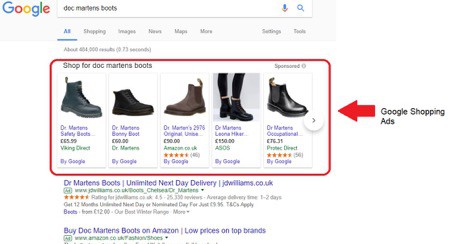
For large retailers it makes sense to have an advertising presence on all popular channels, including Google, Facebook and now Amazon, but for smaller retailers, with a limited budget, it is easy to be stretched too thin.
It can be challenging for smaller retailers to know where to start with their PPC budgets. Google Shopping and Amazon are both behemoths for driving ecommerce sales, yet they are very different tools. Google Shopping takes place in a search engine and Amazon is an online marketplace. The platform that will best suit your company depends on your goals and business model.
Many digital companies have been analysing the battle between Google and Amazon, but Amazon only launched in our home country of Australia in early December last year. Having revolutionised ecommerce in the USA and Europe much is expected of the retail giant, yet early reception here was not quite as positive as anticipated. Many cited a quiet launch and disappointment with the prices on the platform. Perhaps our expectations were set too high given the buzz over Amazon coming from other countries.
Still it is early days for Amazon in Australia and if history is anything to go by, there is no reason it shouldn’t perform well once it finds its feet. Could it be worthy of your PPC budget rather than the trusted Google Shopping platform? Let’s find out by taking an in-depth look at Google and Amazon and how they are helping retailers advertise their products.
Google Shopping
Google Shopping is comprised of ads designed specifically for retailers. Unlike standard AdWords text ads, it lets potential buyers browse ads with product images, price, store, size, colour and other features clearly displayed in the search results.
The benefit for sellers is that they can upload their entire stock to the Merchant Center and Google will automatically show the ads for relevant search queries. This is more efficient than text ads and the images are perfect for ecommerce selling. Below are standard text ads in the Google SERP:
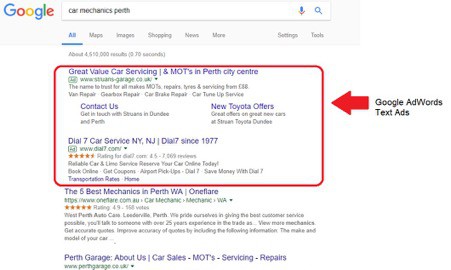
Here is a product-based search prompting visual shopping ads:

By moving to the Google Shopping tab, users can now apply filters and compare a large number of products quickly:
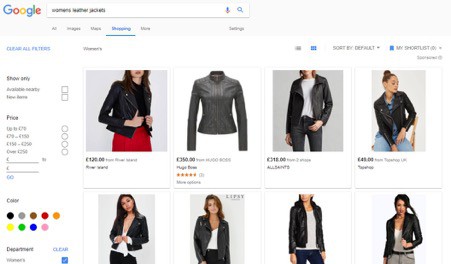
It is a clear benefit for shoppers to be able to compare products and prices in one place before heading to the advertisers’ websites.
Google Shopping is AdWords’ answer to growing ecommerce advertising needs. Advertisers now spend on average 25% of their Google advertising budgets on Google Shopping.
Amazon
On Amazon you can search for products and compare a wide variety of prices. This may sound a lot like Google Shopping but unlike Google you buy on the Amazon platform. With Google Shopping you will head to a brand’s website before completing your purchase.
Some products on Amazon will be supplied directly from Amazon but you also have access to products from “vendors”. Vendors are other businesses who supply their stock to Amazon and use all their shipping and inventory management. There are also “sellers”. These can be any ecommerce business that manage their own stock and shipping but list products on Amazon to be bought via the platform. They are also known as third party sellers.
What are the benefits of Amazon for ecommerce retailers?
- Amazon is highly trusted – Unfamiliar websites always mean taking a chance from a user perspective, whether it’s worries about secure payment data, a terrible checkout system or a confusing site. Amazon offers access to millions of brands but one familiar, easy to use, secure environment with one of the most efficient and simple checkout systems around. If you stayed logged in on Amazon, you can buy in just two rapid clicks. However, will it follow this pattern of gaining trusted account holders for every country in which it launches?
- You don’t need a great website – If your own ecommerce site is low in Google search rankings or still being put together, having Amazon listed products lets you get started with selling online straight away.
- High purchase intent – Certain keywords in Google can indicate high intent e.g. “buy headphones” and using Google Shopping implies high intent but many savvy shoppers will research products on Google but still only convert on Amazon. Increasingly users are going straight to Amazon for their product research and bypassing search engines all together. Recent data reveals 50% of people now start their research on Amazon.
- Less competitive – Ecommerce is a competitive game these days and while there is plenty of competition on Amazon, it is still miles behind Google. This is a benefit for smaller retailers wanting to be seen by consumers.
- Highly personalised data – Google AdWords can look at a huge amount of data for users like demographics, searches conducted, sites visited, geographic location, income and age. Facebook also has impressive access to data in the form of interests, but Amazon’s data is perhaps the most useful for marketing. Amazon knows what you actually bought, repeatedly purchased, added to your wish list, returned and complained about.
- Amazon Prime subscriptions are growing year on year – Amazon Prime now boasts 80 million members in the USA alone. People with Amazon Prime are more dedicated to buying through Amazon because of access to next day delivery. This will certainly be attractive to users all over the world once it launches in their country. The coveted next day delivery might be the biggest method to push new adopters.
- Multiple ad options with lower CPC than Google – As well as just selling on Amazon you can use their own PPC system with Sponsored ads. Amazon Sponsored ads are relatively new compared to Google Shopping and have a lower CPC. Some of the most expensive industries are still only $0.35.
- Running ads aids your organic performance – Running sponsored ads not only gains visibility but pushes sales and therefore the chance for more positive reviews. When you pause your sponsored ads, your organic listing will be much improved.
Amazon ads
When considering the value of Amazon for your ecommerce and PPC budget it is important to understand the format of its advertising options.
To gain sales on Amazon you need to be seen high in product search results. For this you need good reviews. It can be frustrating because new sellers don’t have the visibility for sales and without sales they can’t gain reviews and rise up the ranks.
Sponsored products allow sellers to push their ads to the top of Amazon search results.
There are several types of Amazon ads:
Sponsored Products: Sponsored Products work a lot like AdWords ads. You can bid on keywords to have your ad appear at the top of search results in the platform. When users click they are taken to that product listing on Amazon, so they can add it to their cart.

Sponsored products can also show at the end of page results or on another product’s page:

Headline Ads: These appear above results listings as a headline banner.
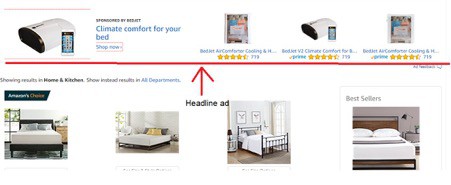
The ads can promote three products together for a brand.
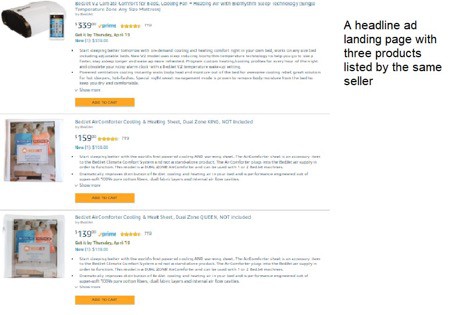
Like Sponsored Products they are charged per click and can target keywords, but their minimum campaign budget is $100.
Amazon Display Ads: These appear to the right of search results in Amazon, at the bottom of the results page, on the customer reviews page, in Amazon marketing emails or at the top of the offers page. They are charged per click but targeted by interest or product category rather than keyword.
What are the benefits of Google Shopping for ecommerce retailers?
- Huge global reach – Google Shopping campaigns are available to far more countries than Amazon Sponsored Products. Over 30 countries can access Google Shopping and the search engine has has 90% market share on mobile, nearly 80% on desktop and over a trillion searches a year. While there are over 300 million Amazon users and that is a substantial audience it is minuscule compared to reaching the trillions of searches per year on Google search.
- Its advertising platforms have more experience – Amazon sponsored products have only been around since 2012. AdWords has existed since 2000. In this time AdWords has improved to become a highly sophisticated, leading PPC platform.
- More advertising options – Google Shopping is just one of many PPC options advertisers can leverage with Google. They can use standard search ads with a plethora of features, display ads across the web, YouTube ads and even integrate their Google Shopping with video ads.
- Improving “intent” knowledge – Amazon users have high intent but so do many Google search users and Google has very recently launched a new algorithm update specifically to better understand the intent of search queries.
- Anyone with a website can use it – With Amazon you need a seller or vendor account. The latter is only available by invitation and not all ad options are available to all seller types.
- No sales commissions – While you are charged per click for Google Shopping ads, once users are on your site you can keep all profits of the sale. Amazon sellers pay a commission to Amazon.
- No subscriptions – To use Amazon Sponsored Products you must sign up for a professional seller account, which charges a $39.99 monthly fee on top of the cost of clicks and commissions. On Google Shopping it costs nothing to have an AdWords and Merchant Center account and you only pay for clicks.
- More optimisation – You can optimise your campaign for device, location, bidding rules, remarketing, CPA and more with Google ads.
- More brand recognition – On Amazon there is less visibility for your brand. With Google Shopping, users convert on your website. You can then remarket to them, more easily cross sell and encourage newsletter sign ups to loyalty schemes.
- The new shopping program – To better compete with Amazon, Google Shopping is improving buying options on mobile. The Shopping Program teams up with retailers and allows a buy now button so users can convert without leaving Google Shopping via a mobile wallet. It also creates a universal shopping cart for cross device conversions, even using voice search on the Google Home assistant. It will charge per sale and utilises Google Express for shipping. However, this is far from a global launch and remains very much in the USA for now.
Google Shopping keeps its crown
Amazon has a remarkable set of benefits for ecommerce advertisers, but Google Shopping. It is, in fact, only a tiny fraction of the countries Google Shopping reaches.
We expect Amazon’s influence to continue to grow but for now one major Google Shopping strength outshines all of Amazon’s appeal.
Amazon has not yet rolled out to as many countries as Google Shopping. It is, in fact, only a tiny fraction of the countries Google Shopping reaches.
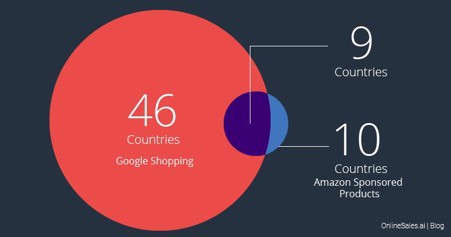
Particularly for our local advertisers in Australia, Amazon is a long way from measuring up to Google’s influence, especially after suffering a somewhat lack lustre launch.
Amazon and Google Shopping both have many advantages for ecommerce retailers but if it’s maximum user reach you’re after or more exposure of your brand then Google Shopping is the clear choice for your initial PPC budget.
With the right digital marketing strategy, you will soon be able to expand your budget to master both platforms and then, through testing, decide which method delivers the best customers and ROI for your business model.
If Amazon is a fairly new presence in your country, it may take time to attract enough accounts and Prime subscribers to be worth dedicating your initial PPC budget towards it. Additionally, it is important to test how your products perform organically on Amazon before investing in the extra cost of sponsored ads.
For countries where Amazon is more established it is a powerful platform, so advertisers should not discount its value. In countries like the USA and UK, Amazon has a huge audience.
As the platform does gain steam in new countries it may be a benefit to place a smaller budget with Amazon while competition remains low to draw in some early wins. It still lacks the impressive ecommerce advertiser market share and reach of Google Shopping, yet 300 million users are worth your attention. It is still a useful audience to tap into and therefore definitely worth a portion of the PPC budget for large retailers who can afford to spread over multiple platforms.
Whichever platform you choose don’t forget to keep testing and refining your strategy for the best conversion results.
Ready to get started on Google Shopping? Take a look at some of our tutorials:
